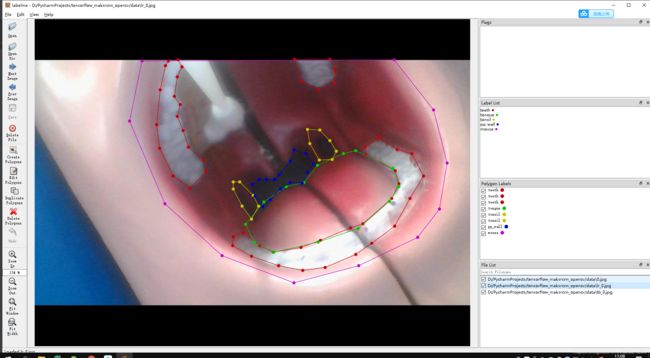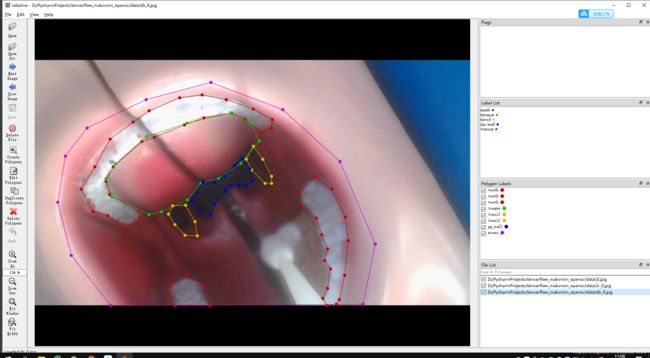编写python脚本对labelme标注的数据集进行左右/上下镜面翻转扩充数据集
编写python脚本对labelme标注的数据集进行左右/上下镜面翻转扩充数据集
labeme是什么?
一个用于标注图像语义分割或者说图像实例分割的标注软件
labelme标注文件格式
- shapes - 标注的多边形数据
- imagePath - 图片路径
- imageData - 图片base64转义的图像数据
- imageHeight - 图像的高度
- imageWidth - 图像的宽度
特别说明
labelme读取的是json文件里的数据,图片数据是读imageData的base64数据而不是原图
Code
from PIL import Image
import os
import glob
import json
import base64
# 数据集路径
path = ".\\data\\"
# 生成数据的保存路径
save_path = ".\\data\\"
# 当前数据集图片格式
file_format = ".jpg"
# 替换格式jpg -> json
replace_format = ".json"
# 左右翻转文件名附加字符
LR = "lr_"
# 上下翻转文件名附加字符
TB = "tb_"
# 获取数据集目录的图片数据集
img_list = glob.glob(path + "*" + file_format)
print("左右翻转-start")
# 1.遍历图片
for i in range(len(img_list)):
# 图片路径
img_path = img_list[i]
# 对应json路径
json_path = img_list[i].replace(file_format, replace_format)
# 判断json文件是否存在
is_exists = os.path.exists(json_path)
if is_exists:
# 打开json文件
f = open(json_path, encoding='utf-8')
# 读取json
setting = json.load(f)
# 获取当前图片尺寸
width = setting['imageWidth']
height = setting['imageHeight']
# 获取中轴
mid_width = width / 2
mid_height = height / 2
print("中轴:x-" + str(mid_width) + ",y-" + str(mid_height))
# 2.遍历shapes
for i2 in range(len(setting['shapes'])):
# 3.遍历每个shapes的点
for i3 in range(len(setting['shapes'][i2]['points'])):
temp_x = setting['shapes'][i2]['points'][i3][0]
temp_y = setting['shapes'][i2]['points'][i3][1]
if temp_x > mid_width:
dis = temp_x - mid_width
new_x = mid_width - dis
elif temp_x < mid_width:
dis = mid_width - temp_x
new_x = mid_width + dis
else:
new_x = temp_x
new_y = temp_y
setting['shapes'][i2]['points'][i3][0] = new_x
setting['shapes'][i2]['points'][i3][1] = new_y
# 从json获取文件名
file_name = setting['imagePath']
# 修改json文件名
setting['imagePath'] = LR + file_name
full_path = save_path + LR + file_name
full_path = full_path.replace(file_format, replace_format)
# 图片转换
pri_image = Image.open(img_path)
# 左右镜面翻转FLIP_LEFT_RIGHT
pri_image.transpose(Image.FLIP_LEFT_RIGHT).save(path + LR + file_name)
# 将转换后的图片进行base64加密
with open(path + LR + file_name, 'rb') as f:
setting['imageData'] = base64.b64encode(f.read()).decode()
string = json.dumps(setting)
# 将修改后的json写入文件
with open(full_path, 'w', encoding='utf-8') as f:
f.write(string)
f.close()
print(img_path + "-------转换完成")
setting = None
else:
print(json_path + "-------文件不存在")
print("左右翻转-end")
# 原理同上
print("上下翻转-start")
for i in range(len(img_list)):
img_path = img_list[i]
json_path = img_list[i].replace(file_format, replace_format)
is_exists = os.path.exists(json_path)
if is_exists:
f = open(json_path, encoding='utf-8')
setting = json.load(f)
width = setting['imageWidth']
height = setting['imageHeight']
mid_width = width / 2
mid_height = height / 2
for i2 in range(len(setting['shapes'])):
for i3 in range(len(setting['shapes'][i2]['points'])):
temp_x = setting['shapes'][i2]['points'][i3][0]
temp_y = setting['shapes'][i2]['points'][i3][1]
if temp_y > mid_height:
dis = temp_y - mid_height
new_y = mid_height - dis
elif temp_y < mid_height:
dis = mid_height - temp_y
new_y = mid_height + dis
else:
new_y = temp_y
new_x = temp_x
setting['shapes'][i2]['points'][i3][0] = new_x
setting['shapes'][i2]['points'][i3][1] = new_y
file_name = setting['imagePath']
setting['imagePath'] = TB + file_name
full_path = save_path + TB + file_name
full_path = full_path.replace(file_format, replace_format)
pri_image = Image.open(img_path)
# 上下镜面翻转FLIP_TOP_BOTTOM
pri_image.transpose(Image.FLIP_TOP_BOTTOM).save(path + TB + file_name)
with open(path + TB + file_name, 'rb') as f:
setting['imageData'] = base64.b64encode(f.read()).decode()
string = json.dumps(setting)
with open(full_path, 'w', encoding='utf-8') as f:
f.write(string)
f.close()
print(img_path + "-------转换完成")
setting = None
else:
print(json_path + "-------文件不存在")
print("上下翻转-end")


